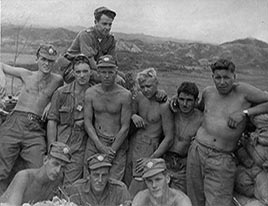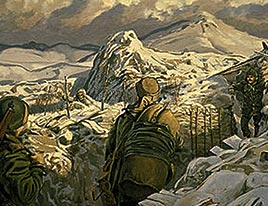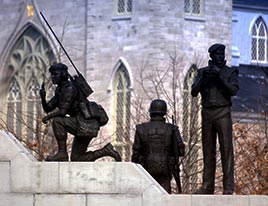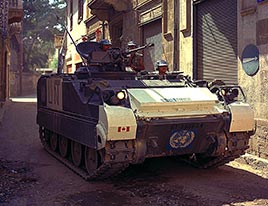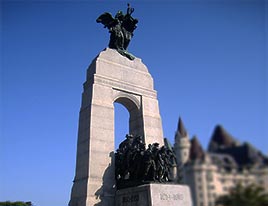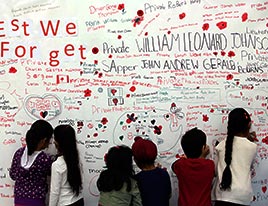Canada Remembers Times - 2014 Edition - Page 3
Twenty-Nine Courageous Canadians
Soldiers from the 2nd Battalion, Royal Canadian Regiment during the Korean War.
(Photo courtesy of Red Butler)
More than 26,000 Canadians served on land, in the air and at sea during the 1950-1953 Korean War. There were famous battles, but not everyone has heard of the 29 courageous Canadians who fought at Song-gok Spur. This handful of soldiers from the 2nd Battalion of the Royal Canadian Regiment were manning a forward outpost in central Korea on the night of November 2–3, 1951, when they were suddenly attacked.
Enemy artillery, mortar and rifle fire pounded in as waves of Chinese soldiers stormed the Canadians. With great skill and courage, the platoon held out for some eight hours against incredible odds, driving the enemy back again and again. One of our men would be killed and more than half wounded in the battle, but the 29 Canadian heroes had done it, effectively stopping a major enemy attack.
Fighting at the Hook
‘Welcome Party’, a painting by Canadian war artist Ted Zuber depicting scene at the Hook.
(Image: Canadian War Museum)
During the Korean War, one of the front-line sectors where our soldiers saw action was in the area nicknamed “the Hook.”
Korea is a rugged land, criss-crossed with many ranges of high hills and deep valleys. After the dynamic early months of the war that saw the fighting rapidly sweep up and down the Korean Peninsula, the front stabilized close to the 38th parallel. The United Nations forces and the communist forces would soon dig in with well-fortified defensive lines that would move little during the rest of the war.
The Hook was a curved piece of high ground on the United Nations’ Jamestown Line, which overlooked the Sami-chon River Valley near where it joins the larger Imjin River. Its strategic location made it a site of sharp clashes. Canadian soldiers spent much time holding the line at the Hook in 1952 and 1953, building up its defences and repelling raids to help ensure it did not fall into enemy hands.
A Heavy Loss in the Middle East
Our country’s ‘Reconciliation’ – The Peacekeeping Monument is located in Ottawa. (Photo: Department of National Defence IC 2002-9012c)
Canada’s long and proud history of service in international peace support efforts is a point of national pride. In recognition of this fact, our country marks National Peacekeepers’ Day every August 9.
This date was chosen because it was on that day, in 1974, that nine Canadian peacekeepers were killed in the Middle East. Their military transport plane was shot down by Syrian missiles. It was the heaviest single day loss our country has ever suffered in a peace support mission.
The service and sacrifice of these nine Canadians—and of all of our brave men and women who have served in these efforts—have not been forgotten.
Keeping the Peace in Cyprus
This year marks the 50th anniversary of Canada’s participation in United Nations peacekeeping efforts in Cyprus. The people of this Mediterranean island were largely of Greek descent, along with a smaller Turkish population. After Cyprus gained its independence from Britain in 1960, long-simmering internal tensions erupted into open violence in 1964.
Canadian peacekeepers patrolling the Green Line in Cyprus in 1974.
(Photo: Department of National Defence CYPC74-295)
Our country would soon intervene with a United Nations peacekeeping effort there. A large contingent of Canadians served in Cyprus between 1964 and 1993. Our soldiers helped diffuse conflicts between the two sides and a fragile peace was maintained for almost a decade. Unfortunately, this balance was rocked in 1974 when thousands of soldiers from neighbouring Turkey invaded and occupied the northern portion of the island. Canadian Armed Forces members suddenly found themselves in the middle of a war zone. The island would end up split into two parts, separated by the “Green Line” buffer zone that runs the full width of Cyprus—a situation that continues today.
More than 25,000 Canadians have served in Cyprus over the past five decades, with 28 losing their lives. While we no longer have a large force there, our country’s commitment continues with Operation Snowgoose. An official Government of Canada delegation recently travelled to the island with Veterans who had served there over the years.
Honouring All Who Have Served
National War Memorial in Ottawa.
(Photo: Veterans Affairs Canada)
The National War Memorial is a powerful tribute to the Canadians who have served in uniform. It stands in Confederation Square, in the heart of downtown Ottawa.
Surmounting this immense granite arch are bronze figures that represent Peace and Freedom. Under the arch, 22 figures represent the hundreds of thousands of Canadians who fought in the First World War. In 1982, the memorial was rededicated to also recognize the sacrifices of those who served in the Second World War and the Korean War.
Sadly, since the Korean War, an additional 1,800 Canadians have died in service. The Government of Canada rededicated the memorial once more in 2014 to honour all of the Canadians who have served in the cause of peace and freedom over the years.
Every November 11th, on Remembrance Day, thousands of people solemnly gather at the National War Memorial. Wreaths are laid and two minutes of silence are observed in memory of all the Canadians who have served.
What’s in a Name?
Students at Thorndale Public School in Brampton, Ontario, write the names of 391 soldiers who died on November 11 in Canada’s wars.
(Photo: Chris So / Toronto Star)
Last year, students at Thorndale Public School in Brampton, Ontario, launched a unique project to remember fallen soldiers and connect with them in a personal way. They created a large mural to honour the 391 Canadian soldiers who died in service on November 11 over the years, from the South African War to today.
Students were assigned one or two soldiers. They learned the names by heart and during a special assembly, went up to the mural and wrote them on the canvas. Many of these students are first-generation Canadians. The children may not have a relative who served in Canada’s past conflicts, but they each developed a connection to our country’s heritage. They now know a name.
By the end of the assembly, the mural was covered with poppies, hearts, maple leaves and Canadian flags scattered among the 391 names. What a great way to remember!
- Date modified:
